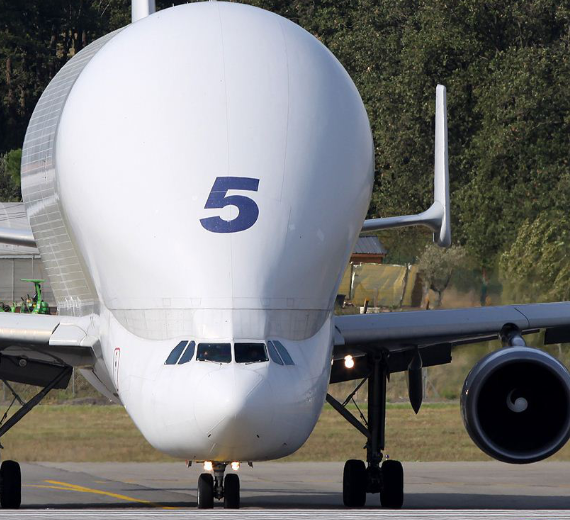 T T |
|
| General information | |
|---|---|
| Type | Outsize cargo freight aircraft |
| Manufacturer | Airbus |
| Status | In service |
| Primary user | Airbus Transport International |
| Number built | 5 |
| History | |
| Manufactured | 1992–c.1999 |
| Introduction date | September 1995 |
| First flight | 13 September 1994; 30 years ago |
| Developed from | Airbus A300-600 |
| Developed into | Airbus BelugaXL |
Developed into Airbus Beluga XL
The A300-600ST Beluga shares many design similarities, although differing substantially in appearance, to the Airbus A300 upon which it was based. The wings, engines, landing gear, and the lower part of the fuselage remain identical to those used on the conventional A300, while the upper part of the fuselage forms an enormous horseshoe-shaped structure 7.7 m (25 ft) in diameter. In comparison with the Super Guppy, the payload was more than doubled and the volume increased by more than 30% The General Electric CF6-80C2 turbofan engines used are slightly uprated from those used on the standard A300 as well. The vertical stabilizer uses a modified A340 fin with a 1.12 m (3 ft 8 in) base extension while the tailplane was strengthened and fitted with auxiliary fins to maintain directional stability. The tailplane trim tank was also deleted.
In January 1996, the Beluga formally entered service, ferrying components from various aerospace sites to the final assembly lines in Toulouse and Hamburg. On 24 October 1997, the last of Airbus's Super Guppy freighters was retired and its outsize cargo mission from that point onwards being exclusively performed by the new A300-600ST fleet. In 1997, the second year of Beluga operations, the fleet accumulated in excess of 2,500 flight hours across more than 1,400 flights. By 2012, the fleet was performing roughly 5,000 flight hours per year; Airbus expected this figure to double by 2017Ceiling
Range
Aircraft Speed
Max Crew


|
On 25 January 2022, Airbus announced a service offering outsize cargo transportation using its BelugaST fleet. Airbus Beluga Transport saw additional demand after sanctions imposed after the 2022 invasion of Ukraine.
In January 1996, the Beluga formally entered service, ferrying components from various aerospace sites to the final assembly lines in Toulouse and Hamburg
Since entering service, the Beluga has been subject to several infrastructure upgrades. In 2011, Pau Pyrénées Airport.
